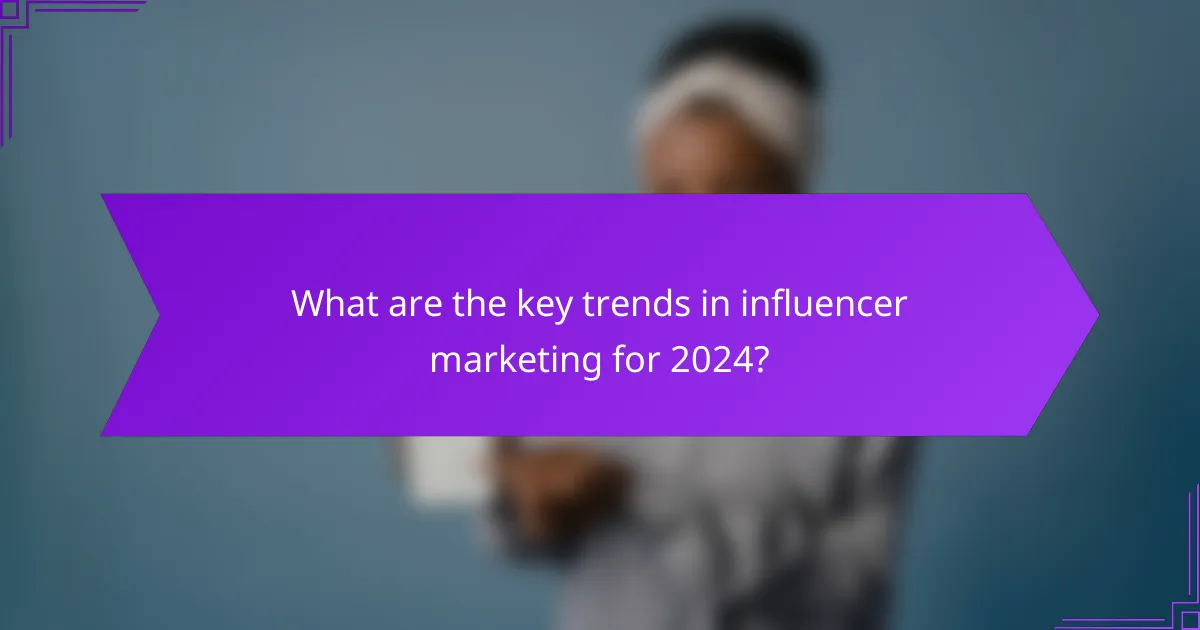Influencer marketing has emerged as a powerful strategy for brands seeking to enhance visibility and build trust with their audiences. By carefully selecting influencers who resonate with their target demographics, companies can foster authentic connections that drive engagement and improve sales conversion rates. Evaluating the effectiveness of these partnerships through performance metrics is crucial for maximizing return on investment and achieving successful campaign outcomes.

How to choose the right influencers for marketing campaigns?
Selecting the right influencers for marketing campaigns involves understanding their audience, engagement, and authenticity. A well-chosen influencer can significantly enhance brand visibility and credibility, leading to better campaign outcomes.
Identify audience alignment
Audience alignment is crucial when choosing influencers. Ensure the influencer’s followers match your target demographic in terms of age, interests, and location. For example, if your product targets young adults, an influencer with a predominantly teenage audience may not be the best fit.
Utilize tools like social media analytics to assess the demographics of an influencer’s audience. This data can help you determine if their followers are likely to engage with your brand.
Evaluate engagement rates
Engagement rates reflect how actively an influencer’s audience interacts with their content. Look for influencers with engagement rates that are higher than industry averages, typically around 1-3% for larger accounts and up to 10% for smaller ones. High engagement indicates a more invested audience.
Consider metrics such as likes, comments, shares, and saves to gauge engagement. A high follower count with low engagement may suggest that the influencer’s audience is not genuinely interested.
Assess authenticity and credibility
Authenticity and credibility are vital for influencer marketing success. Research the influencer’s past content to ensure it aligns with your brand values and messaging. Influencers who are genuine and transparent tend to build stronger trust with their audience.
Check for sponsored posts and how they are received by followers. Authentic influencers often disclose partnerships clearly, which can enhance their credibility.
Consider niche relevance
Niche relevance refers to how closely an influencer’s content aligns with your product or service. An influencer in your industry or a related field is more likely to resonate with their audience about your offerings. For instance, a fitness influencer is a natural fit for health supplements.
Evaluate the influencer’s content to ensure it complements your brand’s message. This alignment can lead to more authentic promotions and better audience reception.
Review past collaborations
Examining an influencer’s previous collaborations can provide insight into their effectiveness and professionalism. Look for case studies or testimonials from brands they have worked with to understand the impact of their partnerships.
Consider the types of products they have endorsed and the outcomes of those campaigns. Successful past collaborations can indicate that the influencer knows how to promote products effectively and engage their audience.

What are the benefits of influencer marketing in the UK?
Influencer marketing in the UK offers significant advantages, including increased brand visibility, enhanced trust among audiences, and improved sales conversion rates. By partnering with influencers, brands can effectively reach targeted demographics and foster authentic connections with potential customers.
Increased brand awareness
Influencer marketing can dramatically boost brand awareness by leveraging the established audiences of influencers. When influencers share content featuring a brand, it exposes the brand to their followers, many of whom may not have been aware of it previously.
For example, a fashion brand partnering with a popular fashion blogger can reach thousands of potential customers in a single post. This exposure can lead to increased website traffic and social media engagement.
Enhanced audience trust
Influencers often have a loyal following that trusts their opinions and recommendations. When influencers endorse a product or service, it can enhance the perceived credibility of the brand. This trust is crucial in the UK market, where consumers tend to favor authentic endorsements over traditional advertising.
Brands should choose influencers whose values align with their own to maintain authenticity. For instance, a sustainable brand should collaborate with eco-conscious influencers to ensure their message resonates with the target audience.
Higher conversion rates
Influencer marketing can lead to higher conversion rates compared to other advertising methods. When influencers promote products, their followers are more likely to make a purchase due to the established trust and relatability.
Brands can track conversions through unique discount codes or affiliate links provided to influencers. This allows for measuring the effectiveness of campaigns and optimizing future strategies based on performance data.
Cost-effective advertising
Influencer marketing can be a cost-effective advertising strategy, especially for small to medium-sized businesses. Collaborating with micro-influencers, who typically have smaller but highly engaged audiences, can yield high returns at a lower cost compared to traditional media buys.
Brands should consider their budget and goals when selecting influencers. A well-planned campaign with the right influencers can deliver significant results without the hefty price tag associated with traditional advertising channels.

How to measure the success of influencer partnerships?
Measuring the success of influencer partnerships involves evaluating various performance metrics to determine their effectiveness. Key areas to focus on include engagement, return on investment (ROI), audience growth, and sentiment analysis.
Track engagement metrics
Engagement metrics are crucial for assessing how well an influencer’s audience interacts with your brand. Key metrics include likes, shares, comments, and click-through rates. Aim for engagement rates of 1-3% as a general benchmark, but this can vary significantly by industry.
Utilize tools like Google Analytics or social media insights to track these metrics. Regularly reviewing engagement can help you adjust your strategy and identify which influencers resonate most with your target audience.
Analyze ROI
Return on investment (ROI) is a vital measure of the financial effectiveness of your influencer partnerships. Calculate ROI by comparing the revenue generated from the campaign to the total costs involved, including influencer fees and production expenses. A positive ROI indicates a successful partnership.
Consider both direct sales and long-term brand value when analyzing ROI. For instance, if an influencer partnership leads to increased brand awareness and customer loyalty, the benefits may extend beyond immediate sales figures.
Monitor audience growth
Tracking audience growth helps determine if your influencer partnerships are expanding your reach. Monitor follower counts, subscriber numbers, and website traffic before, during, and after campaigns. A steady increase in these areas often indicates a successful partnership.
Set specific growth targets, such as a 10-20% increase in followers within a few months, to measure success. Use analytics tools to visualize growth trends and adjust your influencer strategy accordingly.
Evaluate sentiment analysis
Sentiment analysis gauges public perception of your brand following influencer partnerships. This involves assessing the tone and context of comments, reviews, and social media mentions. Positive sentiment can enhance brand reputation, while negative feedback may require immediate attention.
Utilize sentiment analysis tools to automate this process and gain insights into audience feelings. Regularly reviewing sentiment can help you refine your messaging and choose influencers whose values align with your brand.

What are the key trends in influencer marketing for 2024?
In 2024, influencer marketing is expected to see significant shifts, particularly with the rise of micro-influencers, a heightened emphasis on authenticity, and the integration of AI tools. These trends will shape how brands connect with audiences and measure the effectiveness of their campaigns.
Rise of micro-influencers
Micro-influencers, typically defined as individuals with a following of 1,000 to 100,000, are becoming increasingly valuable for brands. Their smaller, more engaged audiences often lead to higher conversion rates compared to larger influencers. Brands are recognizing that these influencers can deliver targeted messages that resonate more deeply with niche markets.
Working with micro-influencers often involves lower costs, making it accessible for small to medium-sized businesses. Collaborations can include sponsored posts, product reviews, or giveaways, allowing brands to leverage authentic connections within specific communities.
Increased focus on authenticity
Authenticity is crucial in influencer marketing as consumers increasingly seek genuine connections with brands. Influencers who share personal stories and experiences tend to foster trust and loyalty among their followers. Brands should prioritize partnerships with influencers who align with their values and can communicate their message authentically.
To enhance authenticity, brands can encourage influencers to create content that reflects their unique style rather than strictly adhering to brand guidelines. This approach can lead to more relatable and engaging content, which is likely to resonate better with audiences.
Integration of AI tools
The integration of AI tools in influencer marketing is transforming how brands identify, engage, and analyze influencer partnerships. AI can assist in finding influencers whose audiences align with a brand’s target demographic, streamlining the selection process. Additionally, AI-driven analytics can provide insights into campaign performance and audience engagement.
Brands should consider utilizing AI tools for tasks such as content optimization and sentiment analysis. These technologies can help refine strategies and improve the overall effectiveness of influencer campaigns, ensuring that marketing efforts are data-driven and results-oriented.

What are the challenges of influencer marketing?
Influencer marketing faces several challenges, including authenticity, audience engagement, and measuring effectiveness. Brands must navigate these hurdles to create successful partnerships that resonate with their target audience.
Authenticity and Trust Issues
Authenticity is crucial in influencer marketing; audiences are quick to spot inauthentic endorsements. Brands should collaborate with influencers whose values align with their own, ensuring that promotions feel genuine and relatable.
To build trust, consider micro-influencers who often have more engaged audiences despite smaller follower counts. Their recommendations can feel more personal and credible, leading to higher conversion rates.
Audience Engagement and Reach
Engaging the audience effectively is a significant challenge. Brands must ensure that their chosen influencers can not only reach a wide audience but also foster interaction and engagement. This involves selecting influencers who actively communicate with their followers.
Utilizing tools to analyze engagement metrics, such as likes, comments, and shares, can help brands assess potential influencers. Aim for influencers with a high engagement rate, as this often translates to more effective campaigns.
Measuring ROI and Effectiveness
Measuring the return on investment (ROI) in influencer marketing can be complex. Brands should establish clear goals and metrics before launching campaigns, such as tracking sales conversions, website traffic, or social media engagement.
Using unique discount codes or dedicated landing pages can help quantify the impact of influencer partnerships. Regularly reviewing analytics will allow brands to adjust their strategies and optimize future campaigns for better results.



